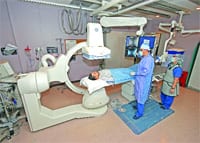Guarding Against Lyme Disease
Lyme disease is an increasing threat in Massachusetts, and of all the infectious diseases that threaten our personal and public health, it can be one of the most problematic.
The number of confirmed cases in the state is climbing rapidly: from 1999 through 2008, the incidence of Lyme disease quadrupled, from just under 1,000 annual cases to nearly 4,000. The latest statistics from the Centers for Disease Control indicate that in 2008 the state ranked second, behind only New York, in the actual number of confirmed and probable cases of Lyme.
Lyme disease is the most commonly reported vectorborne disease in the United States, according to the CDC. (A vectorborne disease is one transmitted to humans or other animals by an insect or other arthropod-type animal. One example is mosquitoes, which transmit West Nile Virus.) Nationally, the number of confirmed and probable Lyme cases reported in 2008 exceeded 35,000, with more than 90{06cf2b9696b159f874511d23dbc893eb1ac83014175ed30550cfff22781411e5} occurring in just 10 states, concentrated in the Northeastern U.S.
The disease was first outlined in 1977 by epidemiologists at Yale University, following an investigation of an outbreak of arthritis among a dozen or so children in Lyme, Conn. The condition is transmitted by tiny ticks, some only the size of a pencil point. These ticks carry what is called a spirochete — a microbe or bacteria identified as Borrelia burgdorferi — that infects humans. The microbe is similar to the spirochete that causes syphilis, and if treated early with antibiotics, the condition can be cured.
The tick latches on to humans for a blood meal, and as it feeds itself, the tick regurgitates the spirochete, or germ, into the human’s bloodstream, infecting the person. If undetected, the tick may feed itself for 24 to 48 hours. Removing the tick before that time period will usually prevent the infection from occurring.
The signature mark of early infection is a rash, appearing anytime between 10 to 20 days after the bite as a red circle and taking the shape of a bullseye with a fleshy clearing in the middle. If you see the rash, you’ve been inoculated with the spirochete, and you should call your doctor.
When contracted, the disease initially presents flu-like symptoms, with accompanying fatigue, fever, headache, and sore muscles and joints. But if the disease is missed, misdiagnosed, or left unattended, the disease can move into secondary and tertiary stages, and that’s when serious problems can occur to joints, the nervous system, and even the heart.
It’s important not to confuse Lyme disease with other conditions such as fibromyalgia or Lupus, which can present similar symptoms. Testing for Lyme disease with a physical exam and blood test can determine if the disease is present. In some instances of late Lyme disease, a condition known as antibiotic-resistant Lyme disease is present. This can occur when the immune system is activated by molecular debris (e.g., dead spirochetal proteins), and can be treated by a rheumatologist with certain immunomodulatory medicines.
Lyme disease can be contracted throughout the year, when the temperature is above freezing and ticks are seeking their blood meal. But ticks are most active in warm weather and present the biggest risk then. According to state statistics, the greatest numbers of cases are reported in July, followed by June and August. Prevalence is also high in May, September, and October. For those who spend a lot of time outdoors or live in tick-infested areas — areas with woods, overgrown grass, or lots of bushes — vigilance is the key.
The most important thing to remember is that early detection is critically important. If caught early, Lyme disease is curable with a regimen of antibiotics, thus preventing those serious health problems.
No vaccine to prevent the disease currently exists, so the best prevention is protection — wearing a long-sleeve shirt and pants, using a repellent with DEET according to instructions, and, most important, performing a ‘tick check’ on yourself after being in tick-infested areas. And pet owners should know that animals can also get Lyme disease, so if you have pets or share space with animals, check them as well. For more information on Lyme disease, visit the state Department of Public Health at www.mass.gov/dph or the CDC at www.cdc.gov.
Dr. Martin Kafina is a rheumatologist at Emerson Hospital in Concord and an instructor at Harvard Medical School.


Comments are closed.